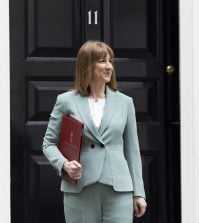The UK budget: behind the headlines

At two events last week, experts picked apart Jeremy Hunt’s Budget – finding heroic optimism, implausible plans, and some hard realities for departments and public servants. Matt Ross listened in
“We are in for a long, hard, unpleasant journey: a journey that has been made more arduous than it might have been by a series of economic own goals,” said Paul Johnson, director of economics think tank the Institute for Fiscal Studies (IFS). The disastrous ‘mini-Budget’ of Liz Truss’s short-lived administration was the most recent of these errors; but, speaking at an IFS briefing on last week’s UK Autumn Statement, Johnson and his colleagues found plenty of other examples (of which, more later).
Alongside global inflationary pressures and the mountain of public debt accumulated since the 2008 financial crisis, these mistakes have left the UK’s public finances deep in the red. So the plans set out by new chancellor Jeremy Hunt make clear that pain is coming for taxpayers and public service users – but not quite yet. “The great majority of the planned consolidation is due only after the next election: there are promises of spending increases over the next two years,” commented Johnson. “And other than the windfall taxes on energy companies, most of the planned tax rises ramp up over time.”
From 2025-26, Hunt starts to squeeze the UK’s deficit – deploying tax rises and spending cuts in a 40:60 ratio. This cuts public services a little more slack than allowed by George Osborne under his 2010-15 austerity policies; but as IFS deputy director Carl Emmerson pointed out, in the post-austerity era there is much less slack to cut. Speaking at an Institute for Government (IfG) event on the same day, IfG programme director Nick Davies noted that if in 2025 the government proceeds with Hunt’s plans to cut £22bn from revenue budgets by 2027-28, “it would be less generous than every Spending Review announcement since 2002, except for 2010 and 2015 – and critically, 2015 proved undeliverable”.
Meanwhile, taxes will rise to unprecedented levels – and stay there. Changes in tax on income, dividends and capital gains produce much of the cash; Hunt also levelled ‘road tax’ on electric vehicles (EVs), and hiked the windfall taxes on hydrocarbons extractors and renewables generators. As a result, the IFS says, taxes will reach 37% of GDP: four points above the long-term average. “With defence spending cuts off the table, an ageing population and pressures everywhere you look, my guess is that we are in a new era of higher taxation,” commented Johnson. “I would be most surprised if the tax burden gets back down to its long-term pre-Covid average at any time in the coming decades.”
Read more: Can new prime minister Rishi Sunak bring stability to UK?
Notably absent was any attempt to reform the tax system: the £1.6bn to be raised from electric vehicles, for example, cannot compensate for the anticipated falls in fuel duty as more people switch to EVs. “There wasn’t much evidence of some over-arching strategy,” commented IfG chief economist Dr Gemma Tetlow at the think tank’s event. Johnson also regretted the lack of reforms: “This increasingly matters,” he said. “Raising badly designed taxes will be more economically damaging than raising sensibly reformed ones.”

So the UK’s hollowed-out public services are in for another evisceration, while the burden of taxation reaches a new and permanent weight. Even so, Hunt has not been able to fit his Budget inside the existing fiscal ‘rules’ – so he’s changed them. “He set himself the loosest of fiscal rules, and is meeting them by a hair’s breadth,” commented Johnson. “Gone is any ambition to get to current budget balance: to borrow only to invest. And getting debt on a downward trajectory relative to national income is aimed at only in five years’ time”, rather than the previous three. Even by 2026-27, the new tax rises and spending cuts total less than half of the increase in borrowing that we’ve seen since March, pointed out Emmerson.
This is a very loose Budget; yet it’s welcomed as a return to economic realities, while Truss and then-chancellor Kwasi Kwarteng’s mini-Budget spooked the markets – driving up the interest rates payable on UK debt. “Perhaps that tells us that the bad market reaction after the mini-Budget wasn’t driven so much by fears of huge near-term borrowing, as much as by the absence of a plan” for repaying the debt, suggested Ben Chu, BBC Newsnight’s economics editor, at the IfG event.
With debt levels rising alongside interest rates, the UK’s spending on interest payments is set to spike at nearly 5% of GDP, settling at around 3%. Since March, forecasts for annual interest costs in 2023-27 have risen from around £50bn to nearly £100bn: “That’s more than spending on any public service bar the NHS,” noted Johnson.
Some of these increased costs are due to Kwarteng’s unforced errors pushing up the interest rate. But there’s another factor at play, explained Richard Hughes, chair of fiscal watchdog the Office of Budget Responsibility (OBR).
Historically, he said, “advanced economies usually have a very long maturity of debt”: issuing bonds that pay out decades down the line, “they’re not rolling over a huge share of their debt stock every year, and having to go back out to markets and get it repriced.” By contrast, emerging economies “don’t have that kind of luxury: they borrow short, because people don’t quite know what their country’s going to look like in 30 years.”
Ever since the credit crunch, however, the Bank of England has been pursuing a policy of ‘quantitative easing’: buying up UK government long-term bonds and issuing short-term debt, it pumps liquidity into financial markets to stimulate the economy. “The net effect is to shorten the average [debt] maturity from, on average, seven years, to an average of two years,” said Hughes, while the stock of debt is also now higher. “In the old days, when you had a one percentage point increase in interest rates, that would add about £2bn to the government’s borrowing costs the following year. Nowadays, with a higher debt stock and shorter maturity, a one percentage point increase in interest rates adds £13bn to the government’s interest costs the following year. And that’s one of the reasons why this particular Autumn Statement felt so painful.”
Departments are set to feel that pain. While councils, schools and the NHS won some protection against spiralling inflation, other departments were left exposed – with spending fixed in cash terms over the next two years. On the ‘GDP deflator’ inflation metric used to determine departmental settlements, they’re set to rise by an average 1%; but as IFS senior research economist Ben Zaranko pointed out, “a 1% increase on average, when combined with increases for some areas, is probably going to mean cuts for others less fortunate.”
Elsewhere, longstanding social care funding reforms designed to cap the amount individuals have to pay have been pushed yet another two years down the line; capital spending is frozen in cash terms after 2025; and overseas aid spending remains depressed – with Hunt sticking here to the old fiscal rules, under which government must be running a current account surplus before its commitment to spending 0.7% of GDP kicks in.
Frighteningly, these numbers are on the optimistic side. While the government bases fiscal policy on OBR forecasts, the Bank of England predicts much slower economic growth: the OBR, Hughes explained, believes that people will dip into their savings to tide them through the coming recession – injecting new funding into the economy – while the Bank fears that they’ll try to preserve them.
Even if the OBR is right, departmental spending figures are flattered both by an underspend last year – meaning that the real squeeze is greater than it appears – and by the use of the GDP Deflator inflation metric, which takes no account of import prices. Excluding inflationary pressures such as soaring energy bills, this metric “isn’t going to perfectly capture cost pressures on public services,” said Zaranko – so the ‘real’ increases in funding set out in Hunt’s numbers are likely to prove illusory.
Real inflation is steeper still for households, which spend a greater proportion of their income on imports such as food; yet even the relatively generous NHS settlement only allows for a 3% pay increase. So while benefits and pensions see a 10.1% rise matching the Consumer Price Index, public servants face another big fall in their spending power.
This comes at a time when many employers are both struggling to recruit staff in a tight jobs market, and losing growing numbers of older, experienced workers. “Why are increasing numbers of older people, post-pandemic, choosing to leave the labour market?” asked Emmerson. Meanwhile, Johnson noted, the OBR expects the number of incapacity and disability claimants to rise by a million by 2026-27. Hunt has responded with a four-year delay to the deadline for moving claimants onto Universal Credit, perhaps in order to push the additional costs past the spending review period – something Johnson called “very odd, and very concerning.”
These losses from the workforce bring an economic hazard, pointed out IFS senior research economist Xiaowei Xu. “Between 2010 and 2019, growth was mainly driven by increasing hours worked,” she said, “with very little growth being driven by capital investment or productivity growth.” So if the workforce shrinks, GDP is likely to fall – something currently averted only by high net immigration, which stands at more than 200,000 annually.
Those productivity rates bring us back to Johnson’s “own goals” – several of which have contributed to the problem. He listed among them public spending cuts by the 2010 coalition government: “Reducing investment spending is not a good way to get growth; or cutting spending on education, particularly huge cuts to vocational and further education,” he said – noting that while Hunt has protected schools, “sixth form and vocational education didn’t get a mention” in the Autumn Statement.
“Very clearly, Brexit was an own goal,” Johnson continued. “Economically speaking, that has been very bad news, and continues to be – particularly the way we’ve done it: the hard type of Brexit”. Kwarteng’s mini-Budget “didn’t help, shall we say? That was another large own goal”.
Zaranko had one for the list: “Failing to deal with some of the fiscal problems we’ve been able to see a mile off slowly trundling down the track”. Falling fuel duty revenues and the ever-growing crisis in social care are the obvious examples. Then there’s “the general economic and political instability and uncertainty that we’ve had over the last several years, which are associated with Brexit,” added Johnson: it has “definitely been a constraint on growth to have three prime ministers and four chancellors in a few months, and to be reversing policy here, there and everywhere”. The mini-Budget, he noted, is both a symptom and a cause of this instability.
Talking of policy reversals, commentators do not expect government to stick to Hunt’s plans. “Beyond the next two years, all the spending numbers should be taken with a large pinch of salt,” said Johnson. “I would be willing to wager a considerable sum that spending will turn out higher than planned – as it literally always does.” Few expect the scheduled 12p rise in fuel duty, capital spending freeze and six-year income tax personal allowance freeze to go ahead as planned.

Even if government can’t deliver its planned cuts and tax hikes, departments and taxpayers can expect a brutal few years after 2025. For households, though, the pain is already here: the OBR’s forecast of a 7% fall in living standards over the next two years is, said Hughes, “just unprecedented, ever since they started collecting records on these things in the 1950s.” And while benefits recipients and pensioners will be compensated, most public servants will see tax burdens rise even as real salaries fall. “It seems doubtful that the government will be able to offer enough to avert widespread strikes, and that’s before we get to 2025-26,” commented Davies. “From then onwards, it’s actually much harder.”
Jeremy Hunt’s budget is, at least, very much more sensible than the Conservative Party’s last attempt. With a clear plan for a relatively progressive set of tax rises, it has calmed markets and stabilised the public finances – albeit bearing a new set of burdens bequeathed by Truss and Kwarteng. But the chancellor’s plans accept much higher public debt and tax levels for the foreseeable future, while concealing some ugly realities for public servants – with departments’ real spending power lower than the headline figures would suggest.
They also rest on some quite heroic assumptions about either future growth, or the ability of the next administration to cut public spending. As Zaranko commented: “After 2025 the plans look, in our judgement, implausibly tight. The hope is clearly that they’ll never have to be implemented – or at least someone else will have to implement them.”
As Hunt works to heal the self-inflicted injuries hampering our economy, he has produced a rather traditional fiscal statement: economically literate, and politically hard-nosed. If Labour wins the next election, they’ll be left holding a public finances plan that is either agonising or undeliverable. And if the Conservatives triumph, they’ll be celebrating first, then worrying about the public finances afterwards.






















